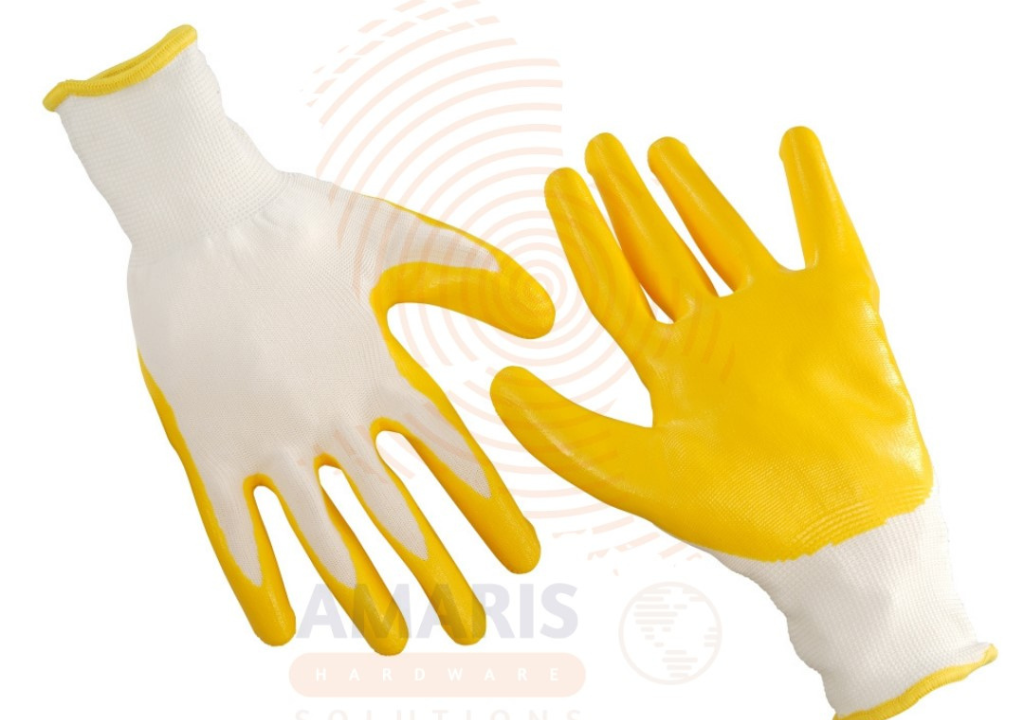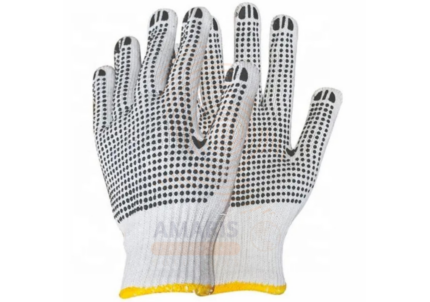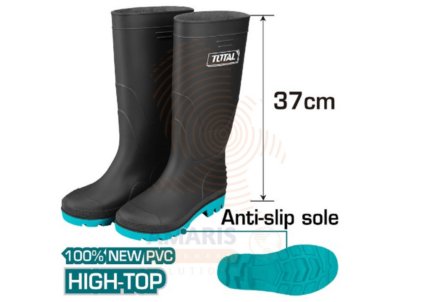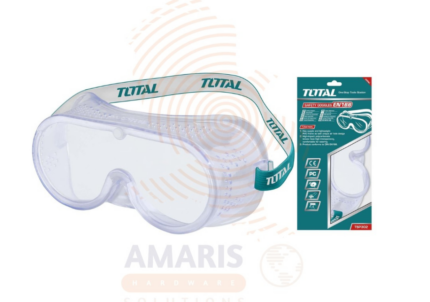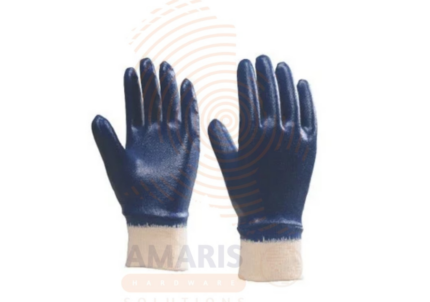
Rubber Coated Gloves (Blue)
$13.58 Original price was: $13.58.$12.90Current price is: $12.90.

Rubber Grout Float
$16.38 Original price was: $16.38.$15.56Current price is: $15.56.
Rubber Coated Gloves (Yellow)
WhatsApp Order
Rubber Coated Gloves (Yellow) are protective handwear designed for improved grip, durability, and safety in industrial, construction, gardening, and general handling tasks. These gloves feature a textured rubber coating—typically on the palm and fingers—over a flexible fabric liner, offering excellent resistance to abrasion, punctures, and light liquid exposure. Their yellow color enhances visibility, making them ideal for work environments where safety and control are critical.
Description
Table of Contents
ToggleRubber Coated Gloves (Yellow)
Uses
-
Construction Work
o Used for handling bricks, lumber, tools, and materials with enhanced grip and reduced injury risk.
o Protects hands from minor abrasions, splinters, and rough surfaces. -
Warehouse and Material Handling
o Provides grip and protection while moving boxes, packages, or pallets.
o Reduces hand fatigue and risk of cuts during repetitive tasks. -
Gardening and Landscaping
o Suitable for digging, planting, pruning, and handling wet or muddy tools.
o Protects against thorns, blisters, and insect contact. -
Automotive and Mechanical Work
o Used for light maintenance tasks involving tools and oily or slippery parts.
o Offers protection from grease, grime, and abrasion. -
General Maintenance Tasks
o Ideal for janitorial duties, light repairs, or equipment handling.
o Keeps hands clean and protected in various work settings. -
Assembly and Manufacturing
o Enhances precision and grip in light assembly lines or packaging stations.
o Reduces risk of product contamination from bare hands. -
Painting and Finishing Work
o Offers a barrier against stains and light chemical splashes.
o Maintains dexterity during delicate handling or detailing. -
Agricultural Work
o Useful in crop handling, equipment use, and farm maintenance.
o Resists punctures and improves handling of tools or containers. -
Waste Handling and Cleaning
o Shields hands from sharp objects, liquids, or mild chemicals in waste disposal.
o Improves grip on bags, bins, and cleaning tools.
SAFETY HANDLING PRECAUTIONS
Safety Precautions
-
Wear Correct Size
o Ensure the gloves fit properly to avoid slippage or discomfort during use. -
Inspect Before Use
o Check for holes, tears, or worn-out rubber areas before each task. -
Avoid High Heat or Flame
o Rubber coating can melt or degrade under high heat; not suitable for welding or hot surfaces. -
Not for Heavy Chemical Handling
o These gloves are not chemical-resistant; avoid use with strong acids or solvents. -
Store Properly
o Keep gloves in a dry, cool place away from sunlight to prevent rubber degradation. -
Wash and Dry Regularly
o Clean after use to remove dirt and oils; allow to air dry thoroughly before reuse. -
Dispose When Damaged
o Replace gloves if rubber peels, fabric weakens, or grip is compromised. -
Use for Intended Tasks Only
o Do not substitute for cut-resistant, thermal, or electrical gloves where required. -
Keep Hands Dry Before Wearing
o Moist hands can reduce grip and cause discomfort or skin irritation.
Related products
Insulated Safety Boots
Insulated safety boots are a type of footwear designed to provide protection for the feet in hazardous work environments while also offering insulation against extreme temperatures. These boots are commonly used in industries such as construction, manufacturing, and utilities where workers are exposed to various risks, including heavy objects, sharp materials, electrical hazards, and cold weather conditions.
Insulated Wire Stripping Pliers
Insulated wire stripping pliers are specialized hand tools designed for safely and precisely removing the insulation from electrical wires. These pliers typically feature specially shaped and sharpened cutting edges, allowing users to strip away the outer insulation without damaging the underlying conductive wires. The tool is also equipped with insulated handles to provide electrical safety for the user when working with live wires. Insulated wire stripping pliers are commonly used in electrical and electronic applications to prepare wires for connections, terminations, or splicing while minimizing the risk of electrical shock or damage to the conductor.
Leather Gloves
Leather gloves are hand-covering garments made from the tanned hides of animals, typically cows, goats, or sheep. These gloves are crafted by cutting and stitching pieces of leather to form protective coverings for the hands. Leather gloves are valued for their durability, flexibility, and ability to provide a comfortable and stylish barrier against environmental elements, making them widely used for various purposes, including fashion, work, and outdoor activities.
Polyester Knit Glove
A polyester knit glove is a type of protective hand wear crafted from polyester fibers using a knitting process. These gloves are characterized by their lightweight, flexible, and breathable nature, making them suitable for a wide range of applications. The knit construction allows for a snug fit and dexterity, while the polyester material provides resistance to abrasions, dirt, and minor cuts. Polyester knit gloves find common use in various industries such as manufacturing, assembly, electronics, food handling, and general-purpose tasks where a balance of hand protection and tactile sensitivity is required.
Rain Boots
Rain boots, also known as Wellington boots or rubber boots, are waterproof footwear designed to protect the feet and lower legs from water and moisture. Typically made of rubber or other waterproof materials, these boots feature a high shaft that extends above the ankle to keep the wearer's feet dry in wet and rainy conditions. The design often includes a slip-on style with a sturdy sole for traction, making them practical for walking through puddles, mud, and other wet environments. Rain boots are commonly worn for outdoor activities during inclement weather to ensure comfort and protection against water.
Safety Goggles (PVC)
Safety Goggles (PVC) are protective eyewear designed to shield the eyes from potential hazards in various environments, such as industrial workplaces, laboratories, or construction sites. These goggles typically feature impact-resistant lenses and a form-fitting frame to provide a barrier against flying debris, liquids, chemicals, or other materials that could cause harm to the eyes. The primary purpose of safety goggles is to enhance eye safety and prevent injuries by creating a physical barrier between the eyes and potential dangers, ensuring a higher level of occupational or recreational safety.
Welding Gloves
Welding gloves are specialized protective hand coverings designed to shield welders from the various hazards associated with welding processes. These gloves are typically made from heat-resistant materials such as leather or flame-resistant fabrics, providing insulation against the intense heat generated during welding. Additionally, welding gloves offer protection against sparks, molten metal, and UV radiation produced during welding operations. They play a crucial role in ensuring the safety of welders by minimizing the risk of burns, cuts, and other injuries to the hands and wrists while allowing for dexterity and control during the welding process.
Welding Googles
Welding Googles are specialized protective eyewear designed to shield the eyes from intense light, sparks, and debris generated during welding processes. They typically feature dark lenses that provide effective protection against the bright arc produced during welding, preventing eye injuries and minimizing the risk of vision damage from ultraviolet (UV) and infrared (IR) radiation. Welding goggles also offer a secure and comfortable fit to ensure the safety and well-being of the wearer while engaged in welding activities.


 Acrylic Sealants
Acrylic Sealants Construction Adhesives
Construction Adhesives Double-Sided Tape
Double-Sided Tape Duct Tape
Duct Tape Electrical Tape
Electrical Tape Epoxy & Resins
Epoxy & Resins Masking Tape
Masking Tape
 Automotive Wrenches & Socket Sets
Automotive Wrenches & Socket Sets Battery Chargers & Jump Starters
Battery Chargers & Jump Starters Car Jacks & Stands
Car Jacks & Stands Car Wash & Detailing Products
Car Wash & Detailing Products Diagnostic Tools
Diagnostic Tools Tire Inflators
Tire Inflators Vehicle Lighting
Vehicle Lighting Oil & Lubricants
Oil & Lubricants
 Adhesives & Sealants
Adhesives & Sealants Bricks & Blocks
Bricks & Blocks Cement & Concrete
Cement & Concrete Drywall & Plaster
Drywall & Plaster Flooring (Tiles, Wood, Laminate)
Flooring (Tiles, Wood, Laminate) Lumber & Plywood
Lumber & Plywood Paints, Primers & Coatings
Paints, Primers & Coatings Insulation Materials
Insulation Materials Roofing Materials
Roofing Materials
 Circuit Breakers
Circuit Breakers Electrical Cables & Wires
Electrical Cables & Wires Switches & Sockets
Switches & Sockets Fuses & Relays
Fuses & Relays Connectors & Terminals
Connectors & Terminals Electrical Boxes & Panels
Electrical Boxes & Panels Conduit & Fittings
Conduit & Fittings Lighting Fixtures & Bulbs
Lighting Fixtures & Bulbs Extension Cords & Power Strips
Extension Cords & Power Strips
 Anchors
Anchors Bolts
Bolts Clips & Clamps
Clips & Clamps Screws
Screws Nuts
Nuts Washers
Washers Rivets
Rivets Nails
Nails Threaded Rods
Threaded Rods
 Hammers
Hammers Measuring Tools (Tapes, Levels, Calipers)
Measuring Tools (Tapes, Levels, Calipers) Screwdrivers
Screwdrivers Pliers & Cutters
Pliers & Cutters Saws & Blades
Saws & Blades Chisels & Punches
Chisels & Punches Allen Keys & Hex Keys
Allen Keys & Hex Keys Ratchets & Socket Sets
Ratchets & Socket Sets Wrenches & Spanners
Wrenches & Spanners
 Power Tool Accessories (Blades, Bits, Discs)
Power Tool Accessories (Blades, Bits, Discs) Rotary Tools
Rotary Tools Saws (Circular, Jigsaw, Reciprocating)
Saws (Circular, Jigsaw, Reciprocating) Drills & Drivers
Drills & Drivers Grinders & Sanders
Grinders & Sanders Heat Guns
Heat Guns Nail Guns
Nail Guns Impact Wrenches
Impact Wrenches Batteries & Chargers
Batteries & Chargers
 Pipes & Fittings (PVC, Copper, PEX)
Pipes & Fittings (PVC, Copper, PEX) Plumbing Tools
Plumbing Tools Pumps & Motors
Pumps & Motors Sealants & Adhesives for Plumbing
Sealants & Adhesives for Plumbing Valves & Taps
Valves & Taps Water Heaters
Water Heaters Drainage Systems
Drainage Systems Faucets & Fixtures
Faucets & Fixtures Hoses & Tubing
Hoses & Tubing
 Hinges & Latches
Hinges & Latches Hooks & Brackets
Hooks & Brackets Window Hardware
Window Hardware Chains & Cables
Chains & Cables Casters & Wheels
Casters & Wheels Shelving & Storage Systems
Shelving & Storage Systems Door Handles & Locks
Door Handles & Locks Drawer Slides & Cabinet Hardware
Drawer Slides & Cabinet Hardware
 Personal Protective Equipment (PPE)
Personal Protective Equipment (PPE) Respirators & Masks
Respirators & Masks Safety Glasses
Safety Glasses Safes
Safes Security Cameras
Security Cameras Gloves
Gloves Helmets
Helmets Ear Protection
Ear Protection Fire Safety Equipment
Fire Safety Equipment Locks & Padlocks
Locks & Padlocks Motion Sensors & Alarms
Motion Sensors & Alarms
 Garden Fencing
Garden Fencing Garden Furniture Hardware
Garden Furniture Hardware Lawn Mowers
Lawn Mowers Trimmers & Edgers
Trimmers & Edgers Shovels & Spades
Shovels & Spades Rakes & Hoes
Rakes & Hoes Pruning Shears & Loppers
Pruning Shears & Loppers Watering Systems (Hoses, Sprinklers, Nozzles)
Watering Systems (Hoses, Sprinklers, Nozzles)
 Interior Paints
Interior Paints Paint Brushes & Rollers
Paint Brushes & Rollers Paint Strippers & Thinners
Paint Strippers & Thinners Paint Trays & Accessories
Paint Trays & Accessories Exterior Paints
Exterior Paints Spray Paints
Spray Paints Primers & Undercoats
Primers & Undercoats Varnishes & Stains
Varnishes & Stains
 Gaskets & Seals
Gaskets & Seals Hydraulic Fittings
Hydraulic Fittings Industrial Fasteners
Industrial Fasteners Industrial Hoses
Industrial Hoses Lubricants & Greases
Lubricants & Greases Metal Sheets & Bars
Metal Sheets & Bars Bearings & Bushings
Bearings & Bushings Belts & Pulleys
Belts & Pulleys
 HVAC Filters
HVAC Filters Insulation for HVAC
Insulation for HVAC Air Conditioners
Air Conditioners Refrigerants
Refrigerants Ventilation Ducts & Fittings
Ventilation Ducts & Fittings Thermostats & Controllers
Thermostats & Controllers Fans & Blowers
Fans & Blowers
 Pegboards & Hooks
Pegboards & Hooks Shelving Units
Shelving Units Storage Bins & Containers
Storage Bins & Containers Toolboxes & Tool Chests
Toolboxes & Tool Chests Workbenches
Workbenches Drawer Organizers
Drawer Organizers Labeling Supplies
Labeling Supplies
 Welding Accessories (Clamps, Brushes)
Welding Accessories (Clamps, Brushes) Welding Electrodes & Rods
Welding Electrodes & Rods Welding Helmets & Gloves
Welding Helmets & Gloves Welding Machines
Welding Machines Soldering Irons & Stations
Soldering Irons & Stations Flux & Solder Wire
Flux & Solder Wire
 Generator Accessories
Generator Accessories Inverters
Inverters Portable Generators
Portable Generators Power Inverters
Power Inverters Transfer Switches
Transfer Switches Diesel & Gasoline Generators
Diesel & Gasoline Generators
 Transport Equipment: Carts, Dollies, and Hand Trucks
Transport Equipment: Carts, Dollies, and Hand Trucks Storage Solutions: Pallets, Racks, and Containers
Storage Solutions: Pallets, Racks, and Containers Lifting Equipment: Hoists, Cranes, and Jacks
Lifting Equipment: Hoists, Cranes, and Jacks Conveyors and Accessories: Belts and Rollers
Conveyors and Accessories: Belts and Rollers